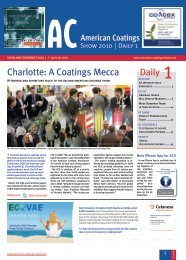Product Presentations - American Coatings
Product Presentations - American Coatings
Product Presentations - American Coatings
Create successful ePaper yourself
Turn your PDF publications into a flip-book with our unique Google optimized e-Paper software.
www.american-coatings-show.com<br />
AC Conference<br />
Delegates Define Main Industry Drivers<br />
Survey shows how industry experts assess the coatings market<br />
H A pre-conference survey among attendees<br />
of the <strong>American</strong> <strong>Coatings</strong> Conference<br />
showed that in the future there<br />
will not be a single major coatings technology<br />
anymore – most respondents<br />
judged functional/smart coatings and<br />
materials as well as waterborne technology<br />
as the most important future<br />
technologies in their industry sector<br />
(see Figure 1).<br />
Sustainable coatings and high solids<br />
were also seen as quite important drivers,<br />
while powder and UV/EB curing<br />
yielded less response.<br />
In contrast, an overwhelming majority<br />
of respondents considered waterborne<br />
technology as the main industry driver<br />
in a pre-conference survey carried out<br />
for the ACS 2010.<br />
It was also interesting to learn that the<br />
industry experts do not seem to expect<br />
an accelerating substitution of tradi-<br />
tional materials by renewables (see Figure<br />
2). When asked to what extent fossil<br />
based raw materials will be replaced<br />
by renewable resources in the next five<br />
years, 40 % of respondents expected<br />
the extent to amount to less than 10 %,<br />
another 40 % of interviewees see the extent<br />
at 20 %. Only 4 % of respondents<br />
expected a share of more than 50 % renewables.<br />
A third question concerned regulations<br />
and legislation relevant to the coatings<br />
industry. A vast majority of respondents<br />
declared that VOC (volatile organic<br />
compounds) regulation occupies them<br />
the most, followed at great distance by<br />
REACH and food contact legislation. Labelling<br />
(GHS), halogen-free flame retardants<br />
and biocides legislation received<br />
much less response.<br />
The results of this poll were presented<br />
in detail at the conference opening during<br />
the Plenary Session on Monday.<br />
Figure 1: ACC participants’<br />
ranking of the<br />
most important future<br />
technologies for their<br />
industry sector<br />
Dow Research Team Wins AC Award<br />
Paper on distribution of TiO 2 convinced the committee<br />
H A team from The Dow Chemical<br />
Company and Dow Coating Materials<br />
won the 2012 <strong>American</strong> <strong>Coatings</strong><br />
Award for its basic research into a<br />
method of measuring the distribution<br />
of titanium dioxide in slurries and<br />
grinds – analysis that promises to<br />
help paint manufacturers reduce the<br />
cost of their products by optimizing<br />
performance of paint coverage. Created<br />
in 2008 by the <strong>American</strong> <strong>Coatings</strong><br />
Association and Vincentz Nework,<br />
the AC Award is given to participants<br />
who submitted the most outstanding<br />
paper to the conference.<br />
Working in conjunction with the federal<br />
National Institute of Standards and Technology<br />
(NIST), award winners Dr. Antony<br />
van Dyk of Dow Coating Materials and<br />
Dr. Alan Nakatani from The Dow Chemical<br />
company said they were interested in<br />
how molecular weight and hydrophilicity<br />
of various polymeric dispersants affects<br />
how titanium dioxide is dispersed in<br />
paints. As titanium dioxide can often be<br />
the most expensive ingredient in a can of<br />
paint, the research can point to ways that<br />
will lower costs of paint. The researchers<br />
bombarded test samples with high speed<br />
neutrons at the NIST Center for Neutron<br />
Research facility in Gathersburg, Md.,<br />
then used sensitive equipment to measure<br />
the scattering of the neutrons.<br />
The researchers said the industry uses<br />
roughly 2 billion pounds of titanium dioxide<br />
annually, a demand that causes<br />
occasional shortages of the critical ingredient.<br />
The high demand for titanium<br />
dioxide coupled with the rising prices<br />
makes it imperative that paint manufacturers<br />
create formulations that maximize<br />
the hiding power of the chemical.<br />
Sonja Schulte of Vincentz Network and<br />
Steve Sides of the <strong>American</strong> Coating Association<br />
gave van Dyk and Nakatani<br />
a trophy and check for $2,500 in prize<br />
money. Schulte said the DOW presenta-<br />
Senthilkumar<br />
Rengasamy,<br />
Eastern Michigan<br />
University<br />
“ Volatile organic compound (VOC)<br />
content is disturbing the environment,<br />
so VOC reduction is a very<br />
important issue for the coatings industry.<br />
The trend goes towards biobased<br />
materials, so raw materials<br />
manufacturers have to pay great<br />
attention to environmental issues.<br />
On the other hand, as a chemist<br />
I can say that it will be difficult to<br />
replace all kinds of fossil-based<br />
raw materials through biobased<br />
ones. But we are on the way there.”<br />
tion was selected because “the research<br />
integrates new and theoretical science,<br />
as well as advanced monitoring and measurement<br />
techniques developed in col-<br />
Figure 2: Delegates’<br />
expectations regarding<br />
the substitution of<br />
fosssil-based raw materials<br />
by renewables<br />
Lee Ju Hiang,<br />
PCTS Specialty<br />
Chemicals Pte<br />
Ltd<br />
“ It is clear that new and novel<br />
coatings technologies will be<br />
required to continue driving<br />
coatings performance. Consumers<br />
expect low-VOC solutions.<br />
That’s why coatings with low<br />
impact on the eco-systems as<br />
well as renewable raw materials<br />
will become more popular. And<br />
the way coatings formulations<br />
will be prepared will change.”<br />
Antony van Dyk<br />
of Dow<br />
<strong>Coatings</strong><br />
Materials<br />
received this<br />
year’s<br />
<strong>American</strong> <strong>Coatings</strong><br />
Award<br />
laboration with NIST.” She added that<br />
the award judges had a record number<br />
of participants in the conference, which<br />
made their job tougher but enjoyable.<br />
5<br />
H<br />
H<br />
H




